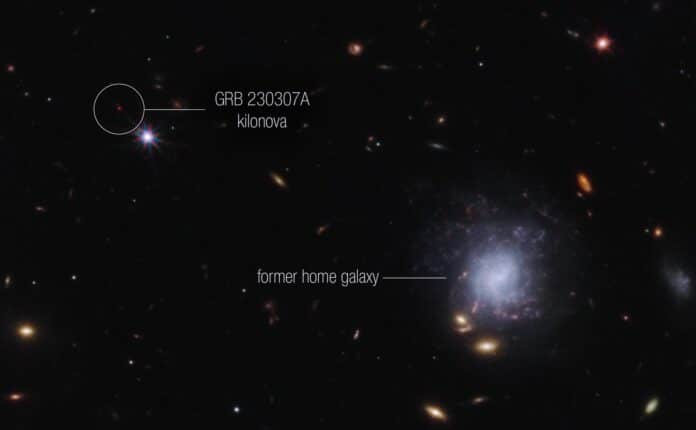A new study by the international research team reported observations of the exceptionally bright gamma-ray burst GRB 230307A. This is the second-brightest gamma-ray burst caused by a neutron star merger.
The team observed this gamma-ray using an array of ground and space-based telescopes, including NASA’s James Webb Space Telescope, Fermi Gamma-ray Space Telescope, and Neil Gehrels Swift Observatory.
GRB 230307A falls within the category of long-duration gamma-ray bursts because of its 200-second duration. This is rare since neutron star mergers often cause short gamma-ray bursts lasting less than two seconds.
Along with this, scientists observed the creation of rare chemical elements. It includes the heavy chemical element tellurium, called Kilonova, in the aftermath of the explosion, and iodine and thorium.
Dr. Ben Gompertz, Assistant Professor of Astronomy at the University of Birmingham and co-author of the study, explains: “Gamma-ray bursts come from powerful jets traveling at almost the speed of light – in this case, driven by a collision between two neutron stars. These stars spent several billion years spiraling towards one another before colliding to produce the gamma-ray burst we observed in March this year. The merger site is the approximate length of the Milky Way (about 120,000 light-years) outside their home galaxy, meaning they must have been launched together.”
“Colliding neutron stars provide the conditions needed to synthesize weighty elements, and the radioactive glow of these new elements powered the Kilonova we detected as the blast faded. Kilonovae are extremely rare and difficult to observe and study, which is why this discovery is so exciting.”
Lead author of the study Andrew Levan, Professor of Astrophysics at Radboud University in the Netherlands, said: “Just over 150 years since Dmitri Mendeleev wrote down the periodic table of elements, we are now finally in the position to start filling in those last blanks of understanding where everything was made, thanks to the James Webb Telescope.”
Dr. Samantha Oates, a co-author of the study while a postdoctoral research fellow at the University of Birmingham (now a lecturer at Lancaster University), said: “Just a few short years ago, discoveries like this one would not have been possible, but thanks to the James Webb Space Telescope we can observe these mergers in exquisite detail.”
The team is now looking forward to learning more about how these neutron star mergers work and how they power these huge element-generating explosions.
Journal Reference:
- Levan, A., Gompertz, B.P., Salafia, O.S. et al. Heavy element production in a compact object merger observed by JWST. Nature (2023). DOI: 10.1038/s41586-023-06759-1
